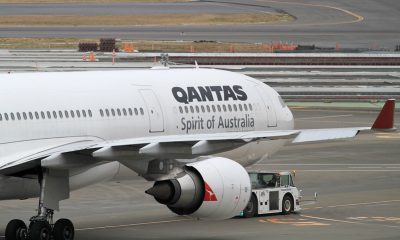Breaking
Underground lab tackles Japan nuclear waste issue
HORONOBE, Japan — Reindeer farms and grazing Holstein cows dot a vast stretch of rolling green pasture here on Japan’s northern tip. Underground it’s a different story.
Workers and scientists have carved a sprawling laboratory deep below this sleep dairy town that, despite government reassurances, some of Horonobe’s 2,500 residents fear could turn their neighborhood into a nuclear waste storage site.
“I’m worried,” said 54-year-old reindeer handler Atsushi Arase. “If the government already has its eye on us as a potential site, it may eventually come here even if we refuse.”
Japanese utilities have more than 17,000 tons of “spent” fuel rods that have finished their useful life but will remain dangerously radioactive for thousands of years. What to do with them is a vexing problem that nuclear-powered nations around the world face, and that has come to the fore as Japan debates whether to keep using nuclear energy after the 2011 disaster at Tokyo Electric Power Co.’s Fukushima plant.
The answer to that problem may lie in the Horonobe Underground Research Center, which has been collecting geological data to determine if and how radioactive waste can be stored safely for as long as 100,000 years in a country that is susceptible to volcanic activity, earthquakes and shifting underground water flows.
Several journalists donned hard hats recently and crammed in small groups into a cage-like mesh elevator for a 350-meter (1,150-foot) descent to reach the laboratory.
They emerged in a 760-meter-long (2,500-feet-long) tunnel cut in the shape of a figure 8, its bare wall showing 3 million-year-old sedimentary layers. Dripping water formed puddles on the ground. Dozens of cables and gauges connected to biscuit-size holes in the wall were analyzing the composition and movement of groundwater and other data around the clock.
In return for hosting the research, which under an agreement with the Japan Atomic Energy Agency doesn’t involve any radioactivity, Horonobe has received about 1 billion yen ($10 million) in government subsidies and tunnel-related public works projects since 2000, according to town statistics.
Officially, this is only a test.
But as with America’s doomed Yucca Mountain project, finding a community willing to host a radioactive dump site is proving difficult, even with a raft of financial enticements. One mayor expressed interest in 2007, and was booted from office in the next election.
Kazuhiko Shimizu, the underground lab’s director general, noted that Horonobe is distant from potential risks, and data samples have so far indicated it might work as a storage site. Exploring an alternative location would take another 20 years, he added.
“It’s a project that takes a lot of time and effort just to get started,” he said. “It’s not easy.”
That kind of thinking makes locals fear they have made a deal with the devil.
“There is no guarantee this test site won’t turn into a final repository,” said 60-year-old dairy farmer Satoshi Sumi. A move by France to convert its test site into a final depository makes him nervous. “I’ve been skeptical about the agreement and I still am.”
The issue is political, not scientific, said Osamu Tochiyama, director of the government-funded Radioactive Waste Disposal Safety Research Center in Tokyo.
Under the current plan, Japan would reprocess the spent fuel so most of it could be reused. The remaining waste would be fused with melted glass into cylinders, and placed in 19-centimeter- (7.5-inch-) thick stainless steel canisters designed to last for 1,000 years – the time it takes for most of the radioactivity to largely decline.
The canisters would be put in cold storage at the Rokkasho reprocessing plant for up to 50 years. Then they would be transported and entombed in a 70-centimeter- (2.3-foot-) thick shield made of bentonite clay before being lowered into deep underground storage in stable bedrock.
The government envisions building a sprawling underground repository about twice the area of Tokyo’s Disneyland at a cost of 3.5 trillion yen ($35 billion) and filling it with waste by 2100.
“Nobody wants to have waste in the neighborhood. But we should all face the reality and think what to do with the waste that already exists, whether you support nuclear energy or not,” Tochiyama said. “It’s wrong to keep putting off a decision and imposing it on the younger generations.”
But more than a decade after Japan founded the Nuclear Waste Management Organization (NUMO) in 2000 to find a site, it is still looking.
The government plans to compile a list of potential sites over the next several months and start negotiations with communities. Officials are tight-lipped about where, because of the strong opposition anticipated.
Globally, only Finland and Sweden have finalized sites for underground waste storage. They are scheduled to open around 2020 and 2029, respectively. France is seeking approval to turn its current test site Bure into a full-fledged repository that would open in 2025.
In the U.S., after abandoning the proposed site at Nevada’s Yucca Mountain, the government is looking at extending the use of interim “dry cask” storage to buy time until a final repository can be found.
The government of Prime Minister Shinzo Abe is pushing to restart some of Japan’s 50 nuclear reactors, which are offline following meltdowns at the tsunami-swamped Fukushima Dai-ichi plant in 2011, and would start producing more waste if switched back on.
Popular former Prime Minister Junichiro Koizumi, previously a supporter of nuclear power, drew attention to the issue last year after visiting Finland’s Onkalo site and coming out against restarts because of Japan’s inability to find a site.
In a report released in May, a panel of experts appointed by the Ministry of Economy, Trade and Industry called the NUMO operation an “aimless journey” and warned of “an imminent, realistic crisis.”
NUMO replaced eight of its 10 board members on July 1. New president Shunsuke Kondo, former head of policymaking at the Japan Atomic Energy Commission, vowed to step up cooperation with the government to move forward with the waste disposal program.
The anticipated removal of highly toxic debris in the coming years from the Fukushima reactors is adding to the sense of urgency. Experts have mixed views about whether their damaged fuel rods and melted debris can be stored in the same way as normal spent fuel.
Japan also may end up with much more waste than anticipated, because its reprocessing trials have been trouble-plagued, and the country is under pressure to abandon the effort altogether, not only because it is expensive but also because it extracts plutonium, the weapons material.
“Therefore when you separate the plutonium from spent fuel you are creating an international security danger,” says Frank von Hippel, a Princeton University nuclear physicist and waste disposal expert.
In April, the government started a feasibility study of disposing of spent fuel rods directly without reprocessing, as Finland, Sweden and the U.S. plan to do. France, a global leader in reprocessing, is pursuing the latter route.
Burying the 4-meter- (13-foot-) long fuel rods would require a bigger site, and additional safety measures to prevent the nuclear chain reaction from starting again.
Mayor Akira Miyamoto says Horonobe has contributed to the nation’s energy policy and will continue to do so. He welcomes the government’s plan to dig an even deeper tunnel 500 meters underground for further experiments.
But he stressed that radioactive materials are unwelcome.
“I understand there will be a final disposal site somewhere in Japan, but not here,” Miyamoto said. “We’re happy to help the government research, as long as it helps to revitalize our town.”
























